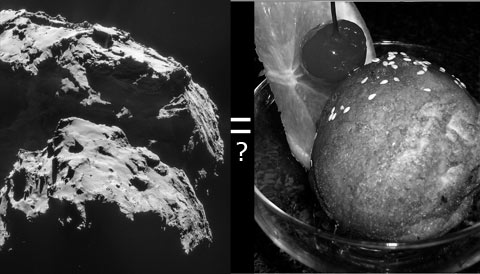
Bright Spots on Ceres Intrigue Scientists
Incoming views of the asteroid belt's largest body reveal spots where ice from the interior might be exposed on the surface.

The Mysterious Martian "Plumes"
An anomalous “cloud” imaged by amateurs in 2012 has puzzled astronomers, spurring some to suggest it was at inexplicably high altitudes above Mars’s surface.

A Star’s Closest Flyby to the Sun
A red dwarf and its brown dwarf companion buzzed through the outer Oort Cloud some 70,000 years ago, around the time when modern humans began migrating from Africa into Eurasia.

Deep Fried Comet Ice
Scientists studying ice here on Earth think they’ve confirmed why comets have hard crusts covered in hydrocarbon gunk.

Pluto and Charon’s Gravitational Dance
This image series, taken by NASA’s New Horizons spacecraft in late January 2015, reveals the dwarf planet Pluto and its largest moon, Charon, orbiting their common center of mass.

The Long-Lived Magnetic Fields of Meteorites
The magnetic fields in the asteroid parent bodies of two pallasite meteorites lasted hundreds of millions of years after our solar system’s formation.

Rosetta Reveals Much About Comet 67P
Once the Rosetta spacecraft arrived at Comet 67P/Churyumov-Gerasimenko last August, European scientists used an array of instruments to assess every nook and cranny of the remarkable two-lobed nucleus.

Mountain-size Asteroid Glides Past Earth
With a small telescope and our sky charts, you can watch the sizable near-Earth asteroid 2004 BL86 race among the stars on the night of January 26–27.

Give-and-Take Origin for Earth's Water?
Where, exactly, did our oceans come from? New research suggests that asteroids might have both delivered and removed lots of water — and that Earth itself might have locked it away deep inside.

Seeing the Sun with X-ray Vision
NASA’s NuSTAR mission recently returned a striking image that shows the Sun’s active regions crackling with X-rays.

Curiosity Studies Mars Dry-out
Samples taken from two drill holes on Mars support the idea that Mars lost a whole lot of water fairly early in its history.

ESA Bids Farewell to Venus Express
A highly successful spacecraft has ended its mission after returning nearly a decade of data on Earth's nearest planetary neighbor.

Help Name Mercury's Craters
The International Astronomical Union is hosting a public contest to name five of Mercury's craters, with a deadline of January 15.

Rosetta Update: Philae Landed in a Hole
The exact location of Philae’s landing site remains unknown, though the site’s topography might allow the lander to operate longer than planned. Meanwhile, Rosetta is detecting organics and heavy elements even when Comet Churyumov-Gerasimenko is far from the Sun.

Curiosity Finds Methane, Other Organics
NASA’s Curiosity rover has detected both methane in Mars’s atmosphere and carbon-bearing organic compounds in its rocks. But it’s unclear where these molecules come from — or whether there’s any biological connection.

MAVEN Finds New Particles, Ion Plume
NASA’s MAVEN mission has discovered a new population of particles in Mars’s upper atmosphere. It’s also found a plume of particles escaping from the planet’s poles, confirming atmospheric loss is happening today.

Earth's Water Likely Not From Comets
An early outcome from Rosetta's scrutiny of Comet 67P/Churyumov-Gerasimenko is that the isotopes in its water have distinctly different ratios than those on Earth.

Geologic Map Shows What's Where on Vesta
NASA's Dawn spacecraft spent 14 months photographing Vesta from close range. Now geologists have completed a global map of the asteroid's surface geology.

New Horizons Awakens for Pluto Encounter
Right on cue, New Horizons spacecraft has awakened from its final electronic hibernation. Seven months from now, it will make the first-ever visit to Pluto.

Hayabusa 2 is Asteroid Bound
Japan's second asteroid-sample mission launched successfully on December 3rd after weather delays. If successful it will reach asteroid 1999 JU3 in 2018, explore for 18 months, and then return to Earth with souvenirs.
